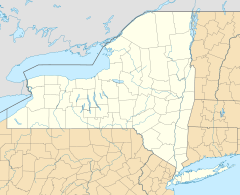Laurel Creek facts for kids
Quick facts for kids Laurel Creek |
|
|---|---|
|
Location of the mouth of Laurel Creek
|
|
| Country | United States |
| State | New York |
| County | Delaware |
| Physical characteristics | |
| Main source | 42°03′18″N 75°19′16″W / 42.055°N 75.3211111°W |
| River mouth | Roods Creek 1,056 ft (322 m) 42°00′56″N 75°21′12″W / 42.0156405°N 75.3532296°W |
Laurel Creek is a natural waterway, often called a small river or stream, located in Delaware County, New York. It plays an important role in the local water system. The creek flows through the landscape, eventually joining a larger body of water known as Roods Creek. This meeting point is found east-northeast of a small community called Hale Eddy.
Contents
Discovering Laurel Creek
Laurel Creek is one of many beautiful natural features in New York State. It helps carry water from higher elevations down to larger streams and rivers. Understanding creeks like Laurel Creek helps us learn about the environment around us.
Where Does Laurel Creek Flow?
Laurel Creek starts its journey in Delaware County. This county is in the southeastern part of New York State. The creek winds its way through the landscape, collecting water as it goes.
The Journey to Roods Creek
The water from Laurel Creek travels until it reaches Roods Creek. Roods Creek is a larger stream that eventually flows into even bigger rivers. This connection shows how all waterways are linked together. The point where Laurel Creek meets Roods Creek is near Hale Eddy. This small area is part of the town of Deposit.
Why Creeks are Important
Even small creeks like Laurel Creek are very important for the environment. They provide homes for many plants and animals. Fish, insects, and other creatures depend on the clean water found in creeks.
Creeks and the Water Cycle
Creeks are a vital part of the water cycle. They help move water across the land. This water can come from rain, melting snow, or underground springs. Creeks carry this water to larger rivers, which then flow into lakes or the ocean. This continuous movement helps keep our planet healthy.
Supporting Local Ecosystems
The areas around creeks are often rich in biodiversity. Trees and plants grow along the banks, providing shade and stability. This helps prevent erosion and keeps the water cool. Many animals use creeks for drinking water and finding food.


